 Traffic paints play a critical role in road safety by providing clear, durable markings that guide drivers and pedestrians alike. These specialized coatings are designed to withstand harsh environmental conditions, heavy traffic loads, and prolonged UV exposure while maintaining high visibility day and night. Available in various formulations such as water-based, solvent-based, thermoplastic, and epoxy systems, traffic paints are tailored to meet the demands of different road types, climates, and safety regulations. Their rapid drying times and strong adhesion properties reduce road closure durations and maintenance costs. In addition, innovations in reflectivity through embedded glass beads and color stability ensure that traffic markings remain effective under all lighting and weather conditions. As urban infrastructure grows and transportation safety becomes increasingly important, traffic paints continue to evolve, incorporating eco-friendly technologies and advanced materials to enhance performance and sustainability worldwide.
Traffic paints play a critical role in road safety by providing clear, durable markings that guide drivers and pedestrians alike. These specialized coatings are designed to withstand harsh environmental conditions, heavy traffic loads, and prolonged UV exposure while maintaining high visibility day and night. Available in various formulations such as water-based, solvent-based, thermoplastic, and epoxy systems, traffic paints are tailored to meet the demands of different road types, climates, and safety regulations. Their rapid drying times and strong adhesion properties reduce road closure durations and maintenance costs. In addition, innovations in reflectivity through embedded glass beads and color stability ensure that traffic markings remain effective under all lighting and weather conditions. As urban infrastructure grows and transportation safety becomes increasingly important, traffic paints continue to evolve, incorporating eco-friendly technologies and advanced materials to enhance performance and sustainability worldwide.

Understanding Traffic Paints and Their Importance
Traffic paints, also known as road marking paints, are specialized coatings applied to road surfaces, parking lots, pedestrian crossings, and airports to create clear visual guidance. Their primary function is to delineate lanes, indicate hazards, guide traffic flow, and improve road safety. Unlike conventional paints, traffic paints are engineered to adhere firmly to asphalt and concrete while resisting wear caused by constant tire friction, weather exposure, and chemical spills.
The choice of traffic paint impacts the overall effectiveness of road markings. High-quality paints ensure consistent visibility in various lighting conditions, including night-time and adverse weather such as rain or fog. Reflective additives, commonly glass beads, are integrated to enhance visibility by reflecting vehicle headlights back to drivers, reducing accidents and enhancing safety.
In addition to safety, traffic paints contribute to infrastructure longevity by minimizing the need for frequent maintenance. Durable coatings reduce costs and disruptions caused by roadworks, ultimately benefiting municipalities and commuters alike. Traffic paints must meet strict standards and regulations that vary by country and region, ensuring they are fit for purpose and safe for public use.
Types of Traffic Paints and Their Applications
There are several primary types of traffic paints, each with unique properties suited to specific environments and requirements:
Water-Based Traffic Paints: These environmentally friendly coatings emit low volatile organic compounds (VOCs) and are preferred in urban areas with strict environmental regulations. They dry relatively quickly and are easy to apply but may require more frequent reapplication in high-traffic zones.
Solvent-Based Traffic Paints: Known for durability and faster drying, solvent-based paints are ideal for heavy traffic roads and highways. They provide strong adhesion and resistance to weathering but have higher VOC emissions.
Thermoplastic Traffic Paints: Applied as molten material, thermoplastic paints form thick, highly durable markings that can last several years. They provide excellent skid resistance and visibility but require specialized application equipment.
Epoxy-Based Traffic Paints: Offering superior chemical resistance and adhesion, epoxy paints are used in industrial areas, airports, and locations with heavy machinery. Their long lifespan and robustness justify their higher initial cost.
Selecting the right type depends on factors such as traffic volume, climate, surface type, and budget. Each paint type plays a vital role in maintaining clear, safe road environments.
Key Features and Innovations in Traffic Paint Technology
Modern traffic paints incorporate advanced features that enhance their functionality and environmental compatibility:
Reflectivity: The addition of glass beads or reflective aggregates significantly improves night-time visibility, ensuring safety for drivers even under low-light conditions.
Fast Drying and Rapid Curing: Innovative formulations allow painted lines to dry and harden quickly, reducing road closure times and minimizing traffic disruptions.
Weather and Chemical Resistance: Traffic paints are designed to withstand rain, snow, UV radiation, and exposure to de-icing salts, oils, and fuels without fading or degrading.
Eco-Friendly Formulations: Low-VOC and waterborne paints reduce environmental impact and improve air quality, aligning with global sustainability goals.
Anti-Skid Properties: Some paints incorporate textures or additives that improve surface grip, enhancing vehicle control and reducing accidents in wet conditions.
Color Durability: Use of advanced pigments prevents fading and discoloration, maintaining clear and consistent markings over time.
These innovations ensure that traffic paints not only perform well under demanding conditions but also contribute to greener, safer infrastructure.
Challenges and Best Practices for Traffic Paint Application
Applying traffic paints requires careful consideration and adherence to best practices to maximize durability and safety:
Surface Preparation: Thorough cleaning and drying of the pavement surface are critical to ensure strong adhesion. Dirt, oil, and moisture must be removed before application.
Optimal Weather Conditions: Paint application should occur in dry conditions with moderate temperatures to facilitate proper curing and adhesion.
Correct Equipment: Depending on paint type, specialized spray machines, extruders (for thermoplastics), or rollers may be used to ensure uniform thickness and pattern accuracy.
Maintenance Scheduling: Regular inspections and timely reapplication preserve visibility and safety, preventing deterioration from wear or environmental damage.
Regulatory Compliance: Paint formulations and application methods must comply with local and international standards, including reflectivity, durability, and environmental impact.
Training and Safety: Personnel applying traffic paints should be trained in proper handling, equipment use, and safety protocols to avoid accidents and ensure quality.
Overcoming these challenges leads to effective, long-lasting road markings that save lives, reduce accidents, and enhance transportation efficiency.
